new posts in all blogs
Viewing: Blog Posts Tagged with: lgbt, Most Recent at Top [Help]
Results 26 - 50 of 71
How to use this Page
You are viewing the most recent posts tagged with the words: lgbt in the JacketFlap blog reader. What is a tag? Think of a tag as a keyword or category label. Tags can both help you find posts on JacketFlap.com as well as provide an easy way for you to "remember" and classify posts for later recall. Try adding a tag yourself by clicking "Add a tag" below a post's header. Scroll down through the list of Recent Posts in the left column and click on a post title that sounds interesting. You can view all posts from a specific blog by clicking the Blog name in the right column, or you can click a 'More Posts from this Blog' link in any individual post.

By: Abbey Lovell,
on 8/5/2014
Blog:
OUPblog
(
Login to Add to MyJacketFlap)
JacketFlap tags:
Books,
History,
american history,
Current Affairs,
America,
LGBT,
lgbtq,
gay rights,
*Featured,
stonewall riots,
unger,
Beyond Nature's Housekeepers,
Beyond Nature's Housekeepers: American Women in Environmental History,
Nancy C. Unger,
kameny,
Add a tag
By Nancy C. Unger
When I was invited by the Commonwealth Club of San Francisco to participate in its month-long program “The LGBT Journey,” I was a bit overwhelmed by all the possibilities. I’ve been teaching “Lesbians and Gay Men in the U.S.” since 2002, and my enthusiasm for the subject grows every time the course is offered. It’s a passion shared by my students. They never sigh and say, “Gay and lesbian history again?”
But what to present in only forty-five minutes? My most recent scholarship examines lesbian alternative environments in the 1970s and 1980s. In the end, though, I decided to make a larger point. For many people, LGBTQ American history begins with the Stonewall Riots in 1969, so I determined to use this opportunity to talk about the history of same-sex desire that is as old as this nation.
To briefly develop that fascinating history, I touch on some of the sodomy trials in the colonial period, in which communities were surprisingly tolerant of men who were well known for seeking sexual contact with other men. I note women in early America who passed as men, often marrying other women, and develop the difficulty in determining if these were lesbians — or simply women who had no other way to earn a living wage, vote, walk the streets unescorted, and enjoy independence and autonomy. Those same questions also apply to the Boston Marriages that began forming in the late 1800s. Professional women (many of whom graduated from the new, elite women’s colleges in the Boston area) entered into lifelong partnerships with other women. Certainly, some were lesbian. But, like passing as a man, being with a person of the same sex is what allowed a woman to have a career, to travel, to enjoy all the independence that came with not being a subservient wife.
Boston Marriages and same-sex intimate friendships became less socially acceptable with increasing public awareness of same-sex desires. The “medicalization” of those desires began in 1870s and 80s, with the term “homosexual” coming into being around 1892. Same-sex sexual behavior acquired a name — and was defined as deviant. Arrests of men begin to increase. And with the presidency of Theodore Roosevelt in 1901, homosexuality became unpatriotic and un-American. As Kevin Murphy develops in Political Manhood, in 1907 Roosevelt warned Harvard undergraduates against becoming “too fastidious, too sensitive to take part in the rough, hurly-burly of the actual work of the world.” He cautioned that “the weakling and coward are out of place in a strong and free community.” The “mollycoddle” Roosevelt warned against was sufficiently similar to emerging definitions of the male homosexual that the two were often conflated, and used to marginalize and stigmatize certain men as weak, cowardly, sissy, and potentially disloyal.
Environmentalists, denounced as being anti-progress, were ridiculed as “short haired women and long haired men.” John Muir, for example, was lampooned as both effeminate and impotent. He was depicted in drag on the front page of the San Francisco Call in 1909 for his efforts to sweep back the waters flooding Hetch Hetchy Valley.
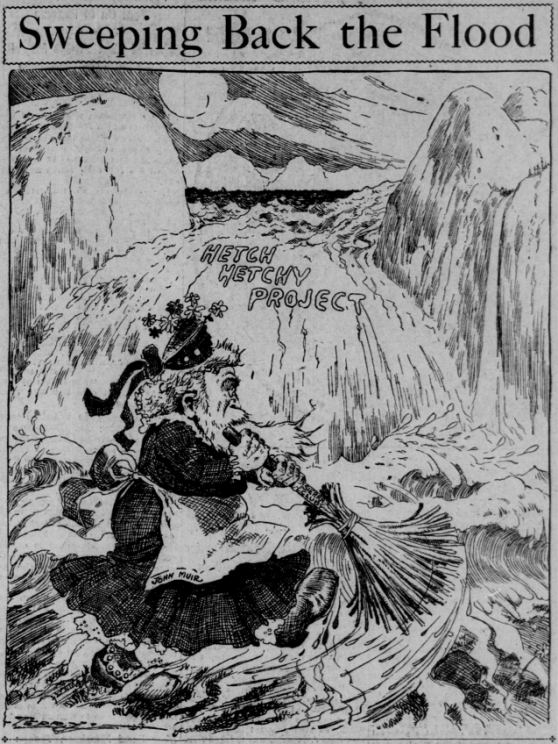
John Muir lampooned for being effeminate in a San Francisco Call cartoon from December 13, 1909. Public domain via the Library of Congress.
Gay men and lesbians operated under a variety of burdens: religious, legal, medical, economic, and social. So how did we get to Stonewall and beyond? Out of changes wrought by World War II and the Cold War came a number of early organizations and challenges to homophobia.
In 1957 it occurred to psychologist Evelyn Hooker that all of the big medical studies on the pathology of the homosexual were based on gay men hospitalized for depression. Her report, “The Adjustment of the Male Overt Homosexual” demonstrated that, despite pervasive homophobia, most self-identified homosexuals were no worse in social adjustment than the general population. Her work was an important step towards the American Psychiatric Association’s decision in 1973 to remove homosexuality from its list of illnesses.
Frank Kameny was a World War II combat veteran who earned his PhD in astronomy at Harvard in 1956. In the middle of the Cold War and the nascent space race, astronomers were at a premium. Kameny, however, was terminated from his position in the US army map service when his arrest on a lewd conduct charge was uncovered. He took his case all the way to the Supreme Court in 1961, but lost. As John D’Emilio notes in Sexual Politics, Sexual Communities, Kameny urged his gay brothers and sisters in 1964 to quit debating whether homosexuality is caused by nature or nurture: “I do not see the NAACP and CORE worrying about which chromosome and gene produced a black skin, or about the possibility of bleaching the Negro [as the solution to racism]. I do not see any great interest on the part of the B’nai B’rith Anti-defamation League in the possibility of solving problems of anti-Semitism by converting Jews to Christians . . . We are interested in obtaining rights for our respective minorities as Negroes, as Jews, and as Homosexuals. Why we are Negroes, Jews, or Homosexuals is totally irrelevant, and whether we can be changed to Whites, Christians, or Heterosexuals is equally irrelevant . . . I take the stand that not only is homosexuality. . . not immoral, but that homosexual acts engaged in by consenting adults are moral, in a positive and real sense, and are right, good, and desirable, both for the individual participants and for the society in which they live.” In 1965 Kameny organized the picketing of the White House to protest homophobia in the government.
Clearly, queer American history did not begin with the Stonewall Riots. It’s a history of oppression that spans several centuries, but also an inspiring story of people fighting for equal rights and acceptance for all Americans.
Nancy C. Unger is Professor of History at Santa Clara University. Her publications include Fighting Bob La Follette: The Righteous Reformer and Beyond Nature’s Housekeepers: American Women in Environmental History. You can follow her on Facebook and listen to her CSPAN lecture on the subject.
Subscribe to the OUPblog via email or RSS.
Subscribe to only American history articles on the OUPblog via email or RSS.
The post The long journey to Stonewall appeared first on OUPblog.


By:
Jason Low,
on 7/29/2014
Blog:
The Open Book
(
Login to Add to MyJacketFlap)
JacketFlap tags:
diversity,
LGBT,
Native American,
Science Fiction/Fantasy,
African/African American Interest,
whitewashing,
Race issues,
Multiracial,
Middle Eastern,
Asian/Asian American,
Latino/Hispanic/Mexican,
The Diversity Gap,
Diversity, Race, and Representation,
Guest Blogger Post,
Add a tag
Summer blockbuster season is in full swing. For many moviegoers, that means escaping to a galaxy far, far away—or perhaps just a different version of our own planet Earth—through science fiction and fantasy movies. As fans clamor for the latest cinematic thrills, we decided to focus our next Diversity Gap study on the level of racial and gender representation in these ever-popular genres that consistently rake in the big bucks for movie studios. We reviewed the top 100 domestic grossing sci-fi and fantasy films as reported by Box Office Mojo. The results were staggeringly disappointing, if not surprising in light of our past Diversity Gap studies of the Tony Awards, the Emmy Awards, the children’s book industry, The New York Times Top 10 Bestseller List, US politics, and the Academy Awards, where we analyzed multi-year samplings and found a disturbingly consistent lack of diversity.
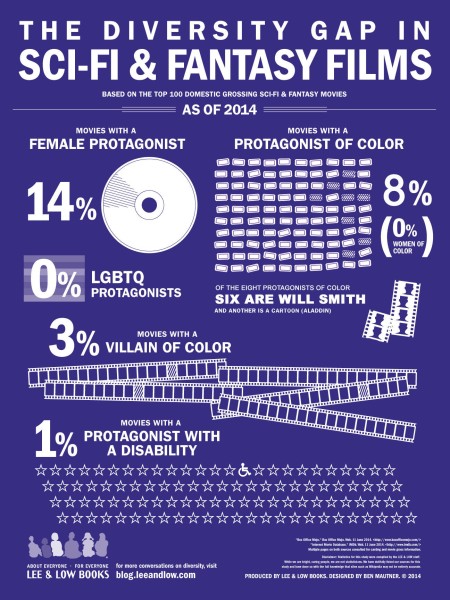
The Diversity Gap in Sci-Fi & Fantasy Films infographic (click for larger image)
Among the top 100 domestic grossing films through 2014:
• only 8% of films star a protagonist of color
• of the 8 protagonists of color, all are men; 6 are played by Will Smith and 1 is a cartoon character (Aladdin)
• 0% of protagonists are women of color
• 0% of protagonists are LGBTQ
• 1% of protagonists are people with a disability
The following interviews with two prominent entertainment equality advocacy groups shed more light on the subject.
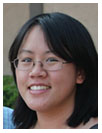
Marissa Lee is co-founder of Racebending.com, an international grassroots organization of media consumers who support entertainment equality. Racebending.com advocates for underrepresented groups in entertainment media and is dedicated to furthering equal opportunities in Hollywood and beyond.
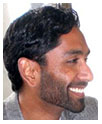
Imran Siddiquee is Director of Communications at the Representation Project, which is a movement that uses film and media content to expose injustices created by gender stereotypes and to shift people’s consciousness toward change. The Representation project was the follow-up to the critically acclaimed documentary Miss Representation.
Jason Low: Do these statistics surprise you? Why or why not?
Marissa Lee: The statistics are certainly striking, especially since sci-fi and fantasy belong to a genre that prides itself on creativity and imagination. These statistics aren’t necessarily surprising, since lack of diversity in Hollywood films is a well-known problem. There have been enough studies and articles, and any moviegoer can pause to notice there is a disparity. . . . Hollywood can’t go on pretending that this isn’t a problem.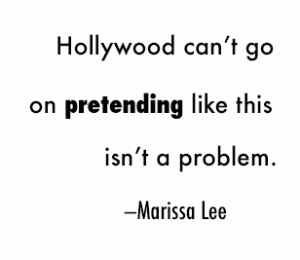
JL: Do you think the American movie-going audience would support a big, blockbuster sci-fi/fantasy movie with a diverse protagonist if a studio made it?
Imran Siddiquee: Yes, definitely. But I think an important thing to understand about Hollywood blockbusters is that they are almost never flukes; they are preordained. Sure, we have the occasional surprise indie hit, but you need a lot of money and marketing behind you to become a blockbuster. Just look at the top ten films in each of the last five years: nearly every single one had a budget of more than $100 million (a lot of them were also sci-fi/fantasy films).
Meanwhile, there hasn’t been a single film released this year starring a person of color with a budget of more than $50 million, let alone a sci-fi film, which is naturally going to be more expensive. The same goes for most of the last decade. So for anyone who might say “people just don’t watch sci-fi movies starring people of color,” or “there’s no evidence that this would work,” the truth is that we have no evidence that it wouldn’t work.
Studios take a couple of massively expensive chances every year on mostly unknown actors or directors—aka giving the Spider-Man franchise to Marc Webb and Andrew Garfield in 2012—but they just don’t take those kinds of chances on people of color. In other words, if Hollywood wanted to make a blockbuster sci-fi/fantasy film starring a woman of color, they definitely could.
ML: I think American audiences would support a film with a diverse protagonist, because we already have. One pullout statistic from your infographic is that Will Smith leads six of the top 100 big sci-fi/fantasy films. His race wasn’t a huge impediment to box office success and may have, in fact, been part of what made him all-American and relatable. That was back in the late 1990s, but since then, Hollywood hasn’t tried to find a new Will Smith. This is kind of ironic, given that Hollywood likes to stick to formulas and sequels! They could push forward another actor—or actress—of color with Smith’s charisma. They haven’t.
The American movie audience supports any movie that Hollywood successfully markets well, especially—but not always—if the film is well produced. Hollywood has managed to market some weird stuff, like a tentpole movie about talking teenage turtle martial artists, or cars that change into space robots, and so on. I don’t buy that when it comes to marketing diverse leads, suddenly this giant industry can’t do it.
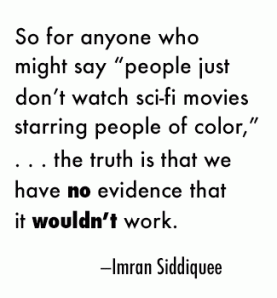 I’d be interested in seeing how many of these top 100 grossing sci-fi and fantasy films star non-human leads. I wonder if there are more films with non-human leads than minority human leads on the list!
I’d be interested in seeing how many of these top 100 grossing sci-fi and fantasy films star non-human leads. I wonder if there are more films with non-human leads than minority human leads on the list!
(Side note: Does the infographic count Keanu Reeves as white or as a person of color? I think he has more than one movie on this list given The Matrix trilogy…)
Editorial note: Yes, Keanu Reeves is counted as a PoC and did make the list for The Matrix. The second Matrix film, The Matrix Reloaded was the only installment of the trilogy to make the top 100 list.
JL: What challenges have you faced or seen peers facing as a woman/person of color, etc.?
ML: There are films with built-in audiences that Hollywood still insists on whitewashing, which has a very adverse effect on actors of color. Let’s be honest, audiences would have still flocked to see The Hunger Games or Twilight if characters like Katniss or Jacob had been cast with people of color as they were written in the books. An actor with a disability could have played the protagonist in Avatar—if we have the technology and imagination to animate a fanciful world populated by blue cat people, we could have cast an actor with a disability similar to the lead character’s in that role. As a result of these casting decisions, up and coming actors from underrepresented groups were deprived of career exposure from being a part of these established franchises, making it harder for Hollywood ever to try and launch a new franchise with an actor from an underrepresented group.
Every single Marvel Studios movie has centered around a presumably straight, white, male protagonist, even if white women (mostly love interests) and men of color (support roles) have played roles in the film. The franchise is a box office juggernaut and has a ton of movies on this list, but we’ve gotten two to three movies about each of the men on the Avengers and there’s yet to be a film about Black Widow. Both of Marvel’s ensemble films—The Avengers and Guardians of the Galaxy—trimmed down the superhero teams for their film adaptations, and the women characters, save for one, were the first to be cut. Most moviegoers will never know that women of color and LGBTQ characters were cut from Guardians of the Galaxy, but audiences will get to relate to the talking raccoon and the talking tree.
More recently, the Divergent franchise cast Naomi Watts to play a character who was a woman of color in the books. It’s a supporting role for an already established franchise, and for whatever reason the production still couldn’t bring themselves to cast an actor of color.
Trends that fans have noted in the media include that in big blockbuster sci-fi and fantasy films, the presence of a straight, white, able-bodied, cis male in some central role in the story is almost guaranteed, while the presence of characters with “minority” identities (e.g. LGBTQ folks, people of color, people with disabilities, women, etc.) is not. Even when a character who isn’t a straight, white cis male is centered in a story, there’s probably a straight, white, cis male character playing second, if not lead, billing. For example, while we can reasonably assume that the next few Star Trek and Star Wars movies will have some diverse characters, we can guarantee that at least one of the leads will be a straight, white man. If The Hunger Games or Twilight had cast actors of color for Katniss or Jacob, there would still have been plenty of lead roles filled by white actors. DC is including Wonder Woman in an upcoming movie, but the film will also feature Batman and Superman.
This means that someone with a lot of intersecting privileged identities (especially straight, white men) will always be able to walk into a multiplex and find a sci-fi/fantasy movie starring someone who shares those identities. If you have a lot of marginalized identities, then representation is a sometimes thing, never a solid guarantee. There is a very small but vocal minority of people who want to maintain this status quo, and Hollywood seems to cater toward them due to institutionalized racism, fear, and habits. But there are just as many, if not more, people who are willing to support, vociferously, films with diverse leads. I wish our money was as good as theirs.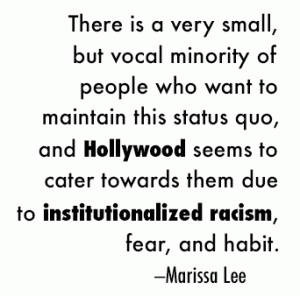
JL: How can consumers encourage more diversity in movies?
IS: Avoid buying tickets to films which clearly rely on stereotypes or demeaning portrayals of people based on gender, race, class, age, sexual orientation, ability, or circumstance. And anytime you do watch a film, give it The Representation Test afterward. The test grades films on their inclusiveness pertaining to all those above categories. When a movie scores really low on the test, use #NotBuyingIt on Twitter to let the filmmakers and all your friends know how you feel. Since so much of this industry is based on money, this is one way we can express our discontent and get the attention of the studios.
ML: Media literacy is a huge start. As media consumers, we should feel empowered to critique the media we consume, and to decide what media we choose to consume. Beyond helpful steps like going to see movies that feature diverse leads, it’s just as important to start conversations in our own communities and with our friends and family (the people we consume media with!) to raise awareness about diversity and representation. Even if we don’t go to see movies that whitewash or exclude or present discriminatory content, people we know will. One way we can help change things is by continuing to start conversations. We need to create an environment where it is safe to criticize popular franchises for lacking diversity. We also need to keep drowning out the malcontents who cannot even handle actors of diverse backgrounds in supporting roles. Social media has really knocked down barriers when it comes to communicating our opinions with Hollywood brass. It’s also given us several spaces where we can discuss the media we consume with our friends and family. In addition, the internet has really changed how we access and consume media. There are Kickstarters and indie channels and online comics and other outlets so we don’t have to be reliant on big production studios or publishers as our only sources of entertainment.
JL: How close or far do you think we are from getting these statistics to change?
IS: When you’re talking about representation that is this low, it’s hard to go anywhere but up. For instance, 0% for women of color in top sci-fi films means I’m being honest when I say things will certainly improve soon, but that’s not saying much. I think we are pretty far away from true equality, or a cinema that reflects and includes the broad diversity of human experiences in the real world.
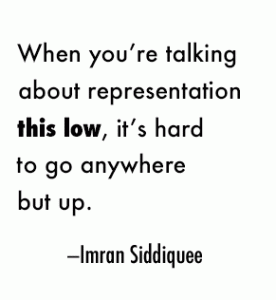 Too many wealthy, white men still run Hollywood, and their decisions still have too much power. As I mentioned earlier, these kinds of movies are very expensive, and so it’s hard for independent or upstart filmmakers to break through or compete.
Too many wealthy, white men still run Hollywood, and their decisions still have too much power. As I mentioned earlier, these kinds of movies are very expensive, and so it’s hard for independent or upstart filmmakers to break through or compete.
That being said, the slight increase in success for white women in blockbuster sci-fi movies, such as Gravity, The Hunger Games, and Divergent, means change is possible. And it’s hard to overstate the importance of the Oscar wins for 12 Years a Slave last year, because while it wasn’t a blockbuster, it is a film that everyone in the industry now knows about and has probably seen. And the whole reason we’re even talking about representation in movies right now is because we know how much seeing different experiences on screen can impact people’s real world thoughts and attitudes. So films like 12 Years a Slave are part of the gradual shifting of consciousness that has to happen in Hollywood to get to a point where studios are consistently greenlighting big-budget films starring people of color.
ML: As budgets for tentpole science fiction and fantasy movies have soared, studios have been more reluctant to take a chance on actors or characters that they perceive as risks. Because people of color and women are also already more likely to consume movies than white people and men, maybe they don’t feel an incentive to change what they are doing because, from their perspective, minorities are perfectly willing to watch films starring white guys. Hollywood is pretty stubborn, especially when it comes to tentpole movies. We are seeing more diversity in television, particularly in children’s television, as well as in online content. The establishment will change when someone influential in Hollywood decides to take the risk and make an effort to diversify their film offerings. The stats in this infographic are focused on profit, not art. For things to change, Hollywood needs to believe that diversity can be profitable.
***
This is not an isolated incident, but a wide reaching societal problem.
Read more Diversity Gap studies on:
The Academy Awards
The Tony Awards
The Emmy Awards
The children’s book industry
The New York Times Top 10 Bestseller List
US politics
Further resources on how to teach content and visual literacy using Lee & Low Books’ infographics series on the Diversity Gap:
Using Infographics In The Classroom To Teach Visual Literacy
CONTACT: For more information or to request permission to reprint, please email hehrlich[at]leeandlow[dot]com
Filed under:
Diversity, Race, and Representation,
Guest Blogger Post,
The Diversity Gap Tagged:
African/African American Interest,
Asian/Asian American,
diversity,
Latino/Hispanic/Mexican,
LGBT,
Middle Eastern,
Multiracial,
Native American,
Race issues,
Science Fiction/Fantasy,
whitewashing 


By: Julia Callaway,
on 7/15/2014
Blog:
OUPblog
(
Login to Add to MyJacketFlap)
JacketFlap tags:
Books,
History,
american history,
charity,
America,
marriage,
LGBT,
lgbtq,
gay rights,
bryant,
same-sex marriage,
drake,
Editor's Picks,
*Featured,
sylvia,
Charity and Sylvia: A Same-Sex Marriage in Early America,
Charity Bryant,
Rachel Hope Cleves,
Sylvia Drake,
hurlburt,
sylvia’s,
of charity,
cleves,
Add a tag
By Rachel Hope Cleves
Same-sex marriage is having a moment. The accelerating legalization of same-sex marriage at the state level since the Supreme Court’s June 2013 United States v. Windsor decision, striking down the Defense of Marriage Act, has truly been astonishing. Who is not dumbstruck by the spectacle of legal same-sex marriages performed in a state such as Utah, which criminalized same-sex sexual behavior until 2003? The historical whiplash is dizzying.
Daily headlines announcing the latest changes to the legal landscape of same-sex marriage are feeding public curiosity about the history of such unions, and several of the books that top the “Gay & Lesbian History” bestsellers lists focus on same-sex marriage. However, they tend to focus on the immediate antecedents for today’s legal decisions, rather than the historical roots of the issue.
At first consideration, it may seem anachronistic to describe a same-sex union from the early nineteenth century as a “marriage,” but this is the language that several who knew Charity Bryant (1777-1851) and Sylvia Drake (1784-1868) used at the time. As a young boy growing up in western Vermont during the antebellum era, Hiram Harvey Hurlburt Jr. paid a visit to a tailor shop run by the two women to order a suit of clothes made. Noticing something unusual about the women, Hurlburt asked around town and “heard it mentioned as if Miss Bryant and Miss Drake were married to each other.” Looking back from the vantage of old age, Hurlburt chose to include their story in a handwritten memoir he left to his descendants. Like homespun suits, the women were a relic of frontier Vermont, which was receding swiftly into the distance as the twentieth century surged forward. Once upon a time, Hurlburt recalled for his relatives, two women of unusual character could be known around town as a married couple.
There were many who agreed with Hurlburt. Charity Bryant’s sister-in-law, Sarah Snell Bryant, mother to the beloved antebellum poet and journalist William Cullen Bryant, wrote to the women “I consider you both one as man and wife are one.” The poet himself described his Aunt Sylvia as a “fond wife” to her “husband,” his Aunt Charity. And Charity called Sylvia her “helpmeet,” using one of the most common synonyms for wife in early America.
The evidence that Charity and Sylvia possessed a public reputation as a married couple in their small Vermont town, and among the members of their family, goes a long way to constituting evidence that their union should be labeled as a same-sex marriage and seen as a precedent for today’s struggle. In the legal landscape of the early nineteenth century, “common law” marriages could be verified based on two conditions: a couple’s public reputation as being married, and their sharing of a common residence. Charity and Sylvia fit both those criteria. After they met in the spring of 1807, while Charity was paying a visit to Sylvia’s hometown of Weybridge, Vermont, Charity decided to rent a room in town and invited Sylvia to come live with her. The two commenced their lives together on 3 July 1807, a date that the women regarded as their anniversary forever after. The following year they built their own cottage, initially a twelve-by-twelve foot room, which they moved into on the last day of 1808. They lived there together for the rest of their days, until Charity’s death in 1851 from heart disease. Sylvia lasted another eight years in the cottage, before moving into her older brother’s house for the final years of her life.
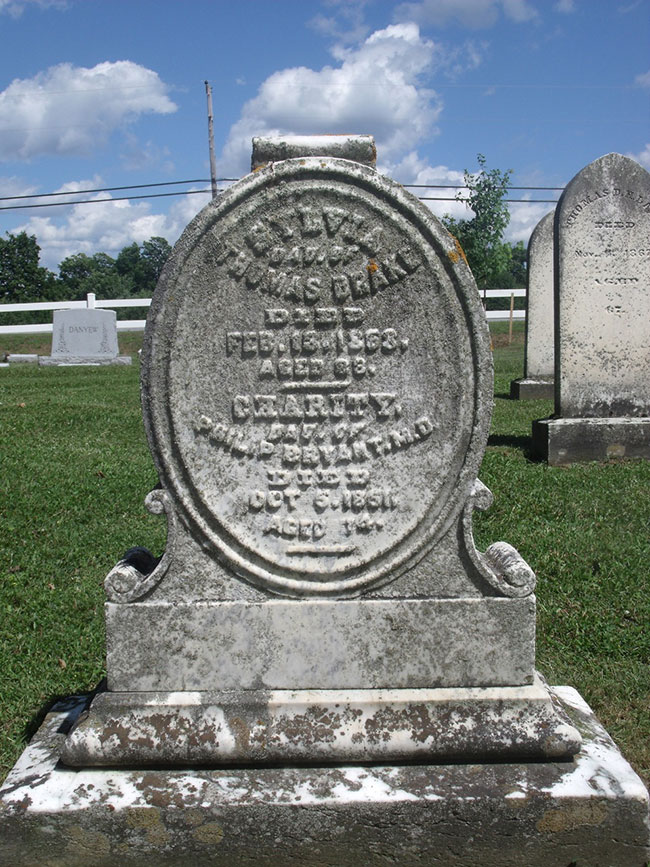
The grave of Charity Bryant and Sylvia Drake. Photo by Rachel Hope Cleves. Do not use without permission.
Of course, Charity and Sylvia did not fit one very important criterion for marriage, common-law or statutory: that the union be established between a man and a woman. But then, their transgression of this requirement likened their union to other transgressive marriages of the age: those between couples where one or both spouses were already married, or where one or both spouses were beneath the age of consent at the formation of the union, or where one spouse was legally enslaved. In each of these latter circumstances, courts called on to pass judgment over questions of inheritance or the division of property sometimes recognized the validity of marriages even where the spouses could not legally be married according to statute. Since Charity and Sylvia never argued over property in life, and since their inheritors did not challenge the terms of the women’s wills which split their common property between their families, the courts never had a reason to rule on the legality of the women’s marriage. Ultimately, the question of whether their union constituted a legal marriage in its time cannot be resolved.
Regardless, it is vital that the history of marriage include relationships socially understood to be marriages as well as those relationships that fit the legal definition. Although the legality of same-sex marriage has been the subject of focused attention in the past decade (and the past year especially), we cannot forget that marriage exists first and foremost as a social fact. To limit the definition of marriage entirely to those who fit within its statutory terms would, for example, exclude two and a half centuries of enslaved Americans from the history of marriage. It would confuse law’s prescriptive powers with a description of reality, and give statute even more power than its oversized claims.
Awareness of how hard-fought the last decade’s legalization battle has been makes it difficult to believe that during the early national era two same-sex partners could really and truly be married. However, a close look at Charity and Sylvia’s story compells us to re-examine our beliefs. History is not a progress narrative, we all know. What’s only just become possible now may have also been possible at points in the past. Historians of the early American republic might want to ask why Charity and Sylvia’s marriage was possible in the first decades of the nineteenth century, whether it would have been so forty years later or forty years before, and what their marriage can tell us about the possibilities for sexual revolution and women’s independence in the years following the Revolution. For historians of any age, Charity and Sylvia’s story is a reminder of the unexpected openings and foreclosures that make the past so much more interesting than our assumptions.
Rachel Hope Cleves is Associate Professor of History at the University of Victoria. She is author of Charity and Sylvia: A Same-Sex Marriage in Early America.
Subscribe to the OUPblog via email or RSS.
Subscribe to only American history articles on the OUPblog via email or RSS.
The post Same-sex marriage now and then appeared first on OUPblog.


By: KatherineS,
on 6/26/2014
Blog:
OUPblog
(
Login to Add to MyJacketFlap)
JacketFlap tags:
*Featured,
stonewall riots,
Science & Medicine,
bisexual,
Online products,
Psychology & Neuroscience,
Oxford Scholarship Online,
LGBT lifestyle,
Pride 2014,
“different”,
homophobia,
lesbian,
Current Affairs,
sexuality,
transgender,
LGBT,
OSO,
gay pride,
gay rights,
Stonewall,
Social Work,
Add a tag
Lesbian, Gay, Bisexual, and Transgender Pride Month (LGBT Pride Month) is celebrated each year in the month of June to honour the 1969 Stonewall riots in Manhattan. This commemorative month recognizes the impact that lesbian, gay, bisexual and transgender individuals have had on history locally, nationally, and internationally.
At Oxford University Press we are marking Gay Pride month by making a selection of engaging and relevant scholarly articles free to read on Oxford Scholarship Online. These chapters broaden the scope of LGBT scholarship by taking a psychological approach to sexuality, examining the arguments of biological difference, and generating important debates on the psychological impact of society’s treatment of minority sexualities.
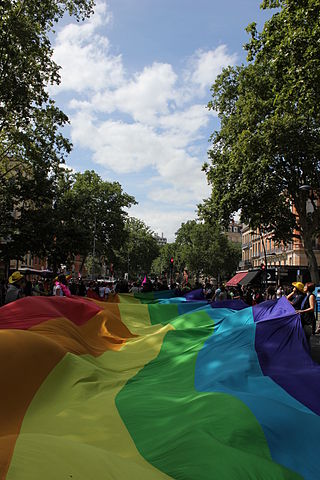 ‘Biological Perspectives on Sexual Orientation’ in Lesbian, Gay, and Bisexual Identities over the Lifespan: Psychological Perspectives
‘Biological Perspectives on Sexual Orientation’ in Lesbian, Gay, and Bisexual Identities over the Lifespan: Psychological Perspectives
What determines an individual’s sexual orientation? Is it biological, environmental, or perhaps a combination of the two? This chapter analyses the argument that sexuality is biologically-determined, carefully weighing the purported evidence, whilst still giving due respect to the often-fluid spectrum of human sexuality throughout the history of our species.
‘Students Who Are Different’ in Homophobic Bullying: Research and Theoretical Perspectives
Being “different” at school can often single a student out for harassment and abuse from their fellow pupils – whether they be of a “different” religion, race, sexuality, or special needs. Setting out the ethnic and cultural factors which influence young people’s aggressive toward behaviour at school, this chapter goes on to a detailed examination of homophobia in educational contexts.
‘The School Climate for Lesbian, Gay, Bisexual, and Transgender (LGBT) Students’ in Toward Positive Youth Development: Transforming Schools and Community Programs
Examine the school climates out of which bullying can develop. It argues that an understanding of this is absolutely crucial for analyzing policy innovations and student wellbeing, and goes on to suggest progressive changes in school policies that could create a more positive school climate for LGBT students.
‘Gay-Friendly High Schools’ in The Declining Significance of Homophobia: How Teenage Boys are Redefining Masculinity and Heterosexuality
What makes a high school gay-friendly? Positive changes have occurred not because of institutions, but because of the increasingly-progressive and inclusive attitudes of the students themselves. Whilst this chapter links the findings with other research that documents decreasing homophobia in the Western world, it also urges continual challenging of the victimization of gay youth, and sets out a masculine identity based on inclusivity, and not heteronormative exclusion.
‘Same-Sex Romantic Relationships’ in Handbook of Psychology and Sexual Orientation
Marriage equality is one of the most hotly-contested social topics currently being debated in Western society, and stirs up passionate arguments from both camps. In ‘Same-Sex Romantic Relationships’, the arguments used by the Conservative Right to prevent marriage equality are examined with empirical evidence. Stereotypically, same-sex relationships are portrayed as being unhappy, maladjusted and promiscuous – is this really the case? Does the legitimizing of same-sex relationships truly have negative social and psychological impacts on society, as opponents of marriage equality often argue?
‘History, Narrative, and Sexual Identity: Gay Liberation and Post-war Movements for Sexual Freedom in the United States’ in The Story of Sexual Identity: Narrative Perspectives on the Gay and Lesbian Life Course
Trace the conception of prejudices and stereotypes which LGBT people still face today. Providing a useful and contextual history of modern and contemporary depictions of homosexuality, this chapter reviews the changing narratives of queer sexuality – from Cold War fears of communism and sexual perversion, to the move toward liberation and acceptance during the 60s and 70s, right through to the AIDS pandemic of the 1980s and the association of homosexuality with illness and death, and the subsequent panic narratives of the 1990s.
Oxford Scholarship Online (OSO) is a vast and rapidly-expanding research library, and has grown to be one of the leading academic research resources in the world. Oxford Scholarship Online offers full-text access to scholarly works from key disciplines in the humanities, social sciences, science, medicine, and law, providing quick and easy access to award-winning Oxford University Press scholarship.
Subscribe to the OUPblog via email or RSS.
Subscribe to only psychology articles on the OUPblog via email or RSS.
Image credits: Flag LGBT pride Toulouse by Léna, CC BY-SA 3.0 via Wikimedia Commons
The post LGBT Pride Month Reading List appeared first on OUPblog.


By:
David Billings,
on 6/25/2014
Blog:
Sparky Firepants Art Blog
(
Login to Add to MyJacketFlap)
JacketFlap tags:
gay,
lesbian,
human rights,
transgender,
LGBT,
Pride,
gay marriage,
LGBT Pride Month,
bisexual,
Sparky Comic Pants,
bi,
carrot cartoon,
LGBT cartoon,
orange cartoon,
Add a tag
 Usually I let the comic do the talking. Today, in the last week of LGBT Pride Month, I want to proclaim our unwavering support for the LGBT community. Everyone has the right to live, love and look the way they feel is right, without fear of retribution or judgment.
Usually I let the comic do the talking. Today, in the last week of LGBT Pride Month, I want to proclaim our unwavering support for the LGBT community. Everyone has the right to live, love and look the way they feel is right, without fear of retribution or judgment.


By: Elizabeth Gorney,
on 6/12/2014
Blog:
OUPblog
(
Login to Add to MyJacketFlap)
JacketFlap tags:
Carlos A. Ball,
family optimality,
Same Sex Marriage and Children,
optimality,
bobjagendorf,
jagendorf,
households,
biologically,
children,
family,
History,
Law,
social science,
Current Affairs,
sex,
lgbt,
parent,
gay marriage,
carlos,
Social Sciences,
*Featured,
Psychology & Neuroscience,
Add a tag
By Carlos A. Ball
Those who defend same-sex marriage bans in the United States continue to insist that households led by married mothers and fathers who are biologically related to their children constitute the optimal family structure for children. This notion of family optimality remains the cornerstone of the defense of the differential treatment of LGBT families and same-sex couples under the law.
There are three main objections to the family optimality claim. The first is a logical objection that emphasizes the lack of a rational relationship between means and ends. Even if we assume that the optimality claim is empirically correct, there is no connection between promoting so-called family optimality and denying lesbians and gay men, for example, the opportunity to marry or to adopt. It is illogical to think that heterosexual couples are more likely to marry, or to accept the responsibilities of parenthood, simply because the law disadvantages LGBT families and same-sex couples.
The second objection is one of policy that questions whether marital and family policies should be based on optimality considerations. The social science evidence shows, for example, a clear correlation between parents who have higher incomes and more education, and children who do better in school and have fewer behavioral problems. And yet it is clear that neither marriage nor adoption should be limited to high-income individuals or to those with college degrees. This is because such restrictions would exclude countless individuals who are clearly capable of providing safe and nurturing homes for children despite the fact that they lack the “optimal” amount of income or education.
It is also important to keep in mind that judges and child welfare officials do not currently rely on optimality considerations when making custody, adoption, and foster care placement decisions. Instead, they apply the “best interests of the child” standard, which is the exact opposite of the optimality standard because it is based not on generalizations, but on individualized assessments of parental capabilities.
Finally, the optimality claim lacks empirical support. Optimality proponents rely primarily on studies showing that the children of married parents do better on some measures than children of single parents (even when controlling for family income) to argue that (1) marriage, (2) biology, and (3) gender matter when it comes to parenting.
The “married parents v. single parents” studies, however, do not establish that it is the marital status of the parents, as opposed to the number of parents, which account for the differences. Those studies also do not show that biology matters because the vast majority of the parents who participated in the studies — both the married parents and the single ones — were biologically related to their children.
As for the notion that parental gender matters for child outcomes, it is the case that most single-parent households in the United States are headed by women. This does not mean, however, that the absence of a male parent in most single-parent households, as opposed to the absence of a second parent, accounts for the better child outcomes found by some studies that compare children raised in married households to children raised in single-parent ones.
In short, the family optimality claim does not withstand logical, policy, or empirical scrutiny. Family optimality arguments, whether in the context of same-sex marriage bans or any other, should be rejected by courts and policymakers alike.
Carlos A. Ball is Distinguished Professor and Judge Frederick Lacey Scholar at the Rutgers University School of Law. His most recent book on LGBT rights is Same-Sex Marriage and Children: A Tale of History, Social Science, and Law.
Subscribe to the OUPblog via email or RSS.
Subscribe to only brain sciences articles on the OUPblog via email or RSS.
The post Three objections to the concept of family optimality appeared first on OUPblog.


By: Julia Callaway,
on 6/2/2014
Blog:
OUPblog
(
Login to Add to MyJacketFlap)
JacketFlap tags:
lesbian,
adult,
Sociology,
Journals,
homosexuality,
LGBT,
lgbtq,
corinne,
family relationships,
intergenerational,
Social Sciences,
*Featured,
oxford journals,
Science & Medicine,
Journals of Gerontology,
journal of gerontology,
gerontology,
corinne reczek,
gay and lesbian couples,
reczek,
by corinne,
corinnereczek,
Add a tag
By Corinne Reczek
The growing support for same-sex marriage rights represents an important shift in the everyday lives of lesbian, gay, bisexual, transgender, and queer (LGBTQ) people in the United States today. However, the continued focus on same-sex marriage in the media, by states, and by local governments, and by scholars and researchers leaves other arenas of the family lives of gay and lesbian adults reletively unexplored.
Of course, like all other Americans, gay and lesbian adults have primary relationships outside of their romantic partnerships. The adult child-parent tie is one of the most enduring and central of our social relationships, with most parents and children having weekly contact, exchanging support and love, and of course experiencing conflict. Indeed gay and lesbian adults keep in steady contact with their family of origin members–most especially parents–as they age into adulthood. Yet, we know virtually nothing about the nature of these intergenerational ties for gay and lesbian adults. While some attention has been paid to the importance parents for LGBTQ adolescents, what happens to the adult child-parent relationships of gay and lesbian adults as they age into mid- and later-life? Do they remain intact? Or are they estranged? Do adult children experience conflict or support? What do these relationships look like?
It is important to pay attention to the adult child-parent relationships of gay and lesbian adults. A child’s non-heterosexual identity has been shown to be associated with negative interactions with later-life parents; later-life parents may be especially unable to accept their gay or lesbian child because they grew up in a sociopolitical era where a gay or lesbian identity was unspeakable at best and pathological at worst. As a result, gay men and lesbian women appear to have fewer family confidants than heterosexuals, and tend to rank social support from friends as more consistent and important than support from family. Yet, gay men and lesbians do maintain contact with parents, even if parents are disapproving of children’s’ sexual identity. How, then, are these relationships negotiated and understood by adult children?
In a recent study on gay men and lesbians in long-term intimate partnerships, I show that there are specific markers of support and strain in gay and lesbian adult child-parent ties. For example, parents demonstrate their support of a gay or lesbian adult child by inclusion through language such as “in-law,” affirmations of support by joining gay rights advocacy groups, and via the integration into every day and special events in ways similar to other adult children. I also found that gay and lesbian adult children know their parents are accepting because parents rely on adult children and their partners for social support and caregiving. While providing social support to parents may be time-consuming and stressful, it is critical for parental well-being and provides an important opportunity for parents to demonstrate trust in gay and lesbian adult children.
The picture, of course, isn’t entirely rosy. The gay and lesbian intergenerational tie is embedded within broader institutional norms of heterosexuality and homophobia, and these broader structural constraints of homophobia and heterosexism contour these negative family interactions–with implications for both generations well-being. It appears, in the present study, that conflict is experienced in ways that are similar to when conflict is experienced in other central aspects of identity or life circumstances, such as religious values, finances, and unemployment. For example, adult children might experience significant rejection in their everyday encounters with parents and experience traumatic events of disownment by their parents. Moreover, adult children suggest that they are scared that their property may be usurped by a parent, rather than be taken care of by a partner, if something were to happen to them.
There’s hope for people who have strained relationships with their parents, however. Key moments, such as family death, illness, or injury, were described as transformative in ways that altered the structure of the adult-child-parent tie from negative to positive. Also, there has been remarkable legal and social change over the past decade, including the federal and state-level legalization of same-sex marriage and decreased public and institutional stigma against gay and lesbian identities. Given this social change, there is strong potential for changing the nature of conflictual intergenerational relationships. Clearly, the years after these social and legal changes may provide new opportunity for supportive intergenerational relationships for adult children coming of age in a new social and political era.
Dr. Corinne Reczek is an Assistant Professor in the departments of Sociology and Women, Gender, and Sexuality Studies at Ohio State University. Dr. Reczek’s research focuses on gay and lesbian families, including relationships between parents and gay and lesbian adult children, same-sex marriage, and the health of minor children in same-sex relationships. Her work was most recently published in The Journals of Gerontology, Series B: Psychological and Social Sciences, her article “The Intergenerational Relationships of Gay Men and Lesbian Women” is freely available to read now” You can find Corinne on Twitter @CorinneReczek.
The Journals of Gerontology® were the first journals on aging published in the United States. The tradition of excellence in these peer-reviewed scientific journals, established in 1946, continues today. The Journals of Gerontology, Series B® publishes within its covers the Journal of Gerontology: Psychological Sciences and the Journal of Gerontology: Social Sciences.
Subscribe to the OUPblog via email or RSS.
Subscribe to only science and medicine articles on the OUPblog via email or RSS.
The post Discussing gay and lesbian adults’ relationships with their parents appeared first on OUPblog.


By: Alice,
on 5/14/2014
Blog:
OUPblog
(
Login to Add to MyJacketFlap)
JacketFlap tags:
Books,
sports,
Current Affairs,
lgbt,
jersey,
*Featured,
Business & Economics,
Sports & Games,
Adam Grossman,
Developing Leaders,
High-Performance Industry,
Sports Strategist,
LGBT sports audiences,
Michael Sam,
NFL draft pick,
sam’s,
qwertyus,
schierbecker,
jerseys,
leagues,
Add a tag
By Adam Grossman
It is rare for a seventh round National Football League (NFL) draft pick to be at the center of the sports world. Then again, Michael Sam is not an average draft pick. Sam is trying to become the first openly gay player to compete for a NFL team.
While it is not clear that Sam will make the St. Louis Rams’ final roster, what is certain is the impact that Sam has already had without playing a down in the NFL. Sam’s story and the conversation it has sparked on sexuality in the NFL has been well documented. What has received less attention is the economic impact Sam could have in helping the NFL reach out to an often non-targeted customer demographic.
Organizations should more heavily seek out lesbian, gay, bisexual and transgender (LGBT) sports audiences as customers. Not only do LGBT demographics have estimated annual buying power of $790 billion, but they are often highly engaged sports fans who are looking to become more involved with leagues and teams. Yet, sports organizations rarely target LGBT audiences in effort to grow revenues. Even as leagues and teams increasingly target new demographics such as women, Latin, African American, and international audiences among other groups, LGBT fans often do not receive the same amount of attention.

Fans flock senior defensive end Michael Sam as he carries his souvenir (a rock from the rock ‘M’ at Memorial Stadium) after the win vs Texas A&M, 30 November 2013. Photo by Mark Schierbecker (Marcus Qwertyus). CC BY-SA 3.0 via Wikimedia Commons
Sam’s jersey sales are one example of why this could be a mistake. As Outsports’ Cyd Zeigler first reported, Sam’s jerseys sales were the second highest among the NFL’s most recent draft class. His jersey has outsold number one overall pick Jadeveon Clowney and number three pick Blake Bortles, the first quarterback taken in the draft. Only Cleveland Browns quarterback Johnny Manziel has more jersey sales than Sam.
Sam’s jersey success is similar to that of NBA Brooklyn Nets center Jason Collins. When he announced he was gay after completing his season playing for the Washington Wizards, Collins jersey became the highest selling jersey for the team. In addition, thousands of orders were placed for Collins jersey when he signed his first 10-day contract with the Nets.
We recognize that not every jersey sale for Sam and Collins was purchased by an LGBT audience member nor is it required to have an openly gay player to target these fans. Yet, Sam and Collins show there is an appetite for products marketed to and by LGBT audiences. For example, sports sponsors have already made significant efforts to pursue the LGBT demographic. During the 2014 Sochi Olympics, Chevrolet produced two commercials featuring gay couples. In addition, Nike has launched the Be True Campaign with products, advertising, and events specifically targeting LGBT demographics throughout the United States.
To the credit many sports organization across the world, there have been significant efforts to encourage equality and tolerance for LGBT athletes, fans, media, and sponsors. The NHL’s combined efforts with the You Can Play Project are a particularly notable example of how sports leagues are trying to take a leadership role in ending homophobia with internal and external audiences.
However, Sam and others demonstrate that sports organizations now have an opportunity to include LGBT audiences as their customers. By targeting LGBT fans, media, sponsors, and supporters now, sports organizations can grow their customer base and gain a competitive advantage.
Adam Grossman is the Founder and President of Block Six Analytics (B6A). He has worked with a number of sports organizations, including the Minnesota Timberwolves, Washington Capitals, and SMG @ Solider Field, to enhance their corporate sponsorship and enterprise marketing capabilities. He is the co-author of The Sports Strategist: Developing Leaders for a High-Performance Industry with Irving Rein and Ben Shields.
Subscribe to the OUPblog via email or RSS.
Subscribe to only business and economics articles on the OUPblog via email or RSS.
The post Sam sells appeared first on OUPblog.

 Title:
Title: A Kiss In The Dark
Author: Cat Clarke
Series: N/A
Published: 3 April 2014 by Quercus
Length: 384 pages
Warnings: brings up sexual assault
Source: publisher
Other info: Cat has written Entangled, Torn, and Undone which I read and reviewed. She also wrote Falling, a shorter story, which I read and enjoyed.
Summary : When Alex meets Kate the attraction is instant. Alex is funny, good-looking, and a little shy – everything that Kate wants in a boyfriend. Alex can’t help falling for Kate, who is pretty, charming and maybe just a little naive… But one of them is hiding a secret, and as their love blossoms, it threatens to ruin not just their relationship, but their lives.
Graph: This is a new feature I am trialling which I will use when my opinion of things or levels of devices like scares, tension, interest, fun, laughs (anything really) fluctuate throughout a book. Tell me what you think of it and if I should do more.
Review: Alex gets to know Kate via the internet. Alex meets Kate at a concert. They start going out. They're perfect for each other. Except Alex is a girl (I don’t feel bad for telling you that because we learn this within the first 15 pages). And Kate doesn't know.
Cat Clarke is one of the authors whose name guarantees I'll read a thing. I wasn't sure what to expect from this, but it was totally different to anything I may have wanted to expect.
Cat Clarke always manages to write perfectly real characters, and those in A Kiss in the Dark are no exception. they interact and react well, and all the minute of emotions that Alex and Kate feel about being in love is valid and accurate.
I am in love with all characters in the Before. Alex slightly less than Kate because while I see why she would do that, it's quite a big thing to not be open about, and I prefer my romantic couples to not have secrets this big. I didn't like Kate in the After. I get it, finding out your boyfriend is a girl is quite big and she has the right to be upset with Alex for keeping such a big secret. But I really dislike people who do what she did. she redeems herself in the closing pages, but still. My favourite character was Jamie Alex's brother. He's supportive, a bit funny, and loyal. I found Astrid a little annoying.
The best thing in this was the tension, especially in the first half. From the moment Alex chooses not to tell Kate she's a girl, and they go out, as the romance builds, which I think is one of the most adorable things ever despite my general wariness of romance when they’re keeping such huge secrets from each other, you’re just thinking ahead to what's going to happen when she finds out; so every kiss and every smile they share, is slightly tainted by the fact you just know it’s going to broken and you just have to keep reading to see how it goes. and then ohmigosh Cat puts in 14 words that ramp up the tension so much and then it all happens and ugh perfectness. The day I read this, I highly disliked school. It stopped me reading this.
Overall: Strength 5 tea to a to a truly unputdownable book.

By: Nina @ Death Books and Tea,
on 3/31/2014
Blog:
Death Books and Tea
(
Login to Add to MyJacketFlap)
JacketFlap tags:
news,
lgbt,
ukya,
Add a tag
Argh!! Six weeks until exams! Totally not procrastinating. *procrastinates* (I am actually getting some revision done. Of the stuff I get. *pretends that the Cold War is not on our syllabus after awful teaching*)
Anyway. Things are happening.
I have books. I have Essence by Lisa O Kane from Netgalley, which I'm reading for my stop on the
Countdown to June 5th. It's going to be an epic tour, with lots of authors and bloggers. Thanks to Jim for hosting it!!
I also have Bone Jack (thank you Andersen Press), Hate (thank you, Indigo), and some other books I can't think of right now but will tell you I got from publishers when I review them.
I also have lots of books I don't want. Shout if you want them.
Usual postage costing rules apply.

Divergent premiere. So good. You should see the film when you have the chance. I'll tell you more in another post.
Laure Eve is holding a challenge!
Paper vs Pixels! For all of April, we can only consume books in one format. Due to my giant pile, and my need to reduce it, I pick paper! It's going to be hard. Sorry, millions of netgalley things... I am still going to be using my kindle (half my revision stuff is on it!) but books will be paper only. What will you choose?

You know how much I endorse queer fiction.
LGBTApril is an event being held by Cayce (Fighting Dreamer) and Laura (Laura Plus Books). You can do anything, as long as you do something related to lgbt fiction. I am going to (after revision) do a post breaking down genre in major LGBT fiction, because off the top of my head, I think queer people are more visible in contemporary and fantasy, and not many dystopians, but then I got suggested a few dystopians and I'm all 1) how did I not know these existed? and 2)how do the numbers really add up? Look forwards to that in a few weeks.
Marriage equality laws came into effect on Saturday! I am really pleased about this, because it means that queer couples do get their coupleness (actually can't think of a better word right now) recognized in the same way as people with different sexes do. But I can't help but find flaws in the system
. Inherently human has a great post on inequalities with gender within the act, and I just think that the push for marriage equality has been at the forefront of lgbt activity, when there are a lot more less pretty, more pressing issues that need to be dealt with too such as youth homelessness and mental health care and suicide rates and intersectionality (lack of). However, marriage equality is a great step towards equality, and I'm happy for all the couples that got a day they'd been waiting for for ages. Here's hoping we can go further.

I'm sure none of you are unfamiliar with Lucy the Reader and Project UKYA. But in case you don't know, April will be a
UKYA Extravaganza! Check out @lucythereader and @projectukya for more info.
Campers! Campnanowrimo is here for April! I'm not participating, as I have other things to do and just about have carved out a regular writing schedule. But if you can, and you want to, do. Awesome people will be writing with you.
Anyone here on twitter? If so, you should totally enter this competition held by Quercus.
"Tweet why you want a signed competition copy of Cat Clarke’s A Kiss in the Dark between the 31st March and 4pm on 4th April. Make sure you @Cat_Clarke & include the #AKITD to be in with a chance of winning. The winner will be announced on Friday 4th at 4:30pm. Good luck."
I have A Kiss in the Dark on my To-Read pile, and I'll be reading it for Paper vs Pixels. I recommend you read it because...well, it's Cat, who is a totally awesome author (find my love for her
here).
So, that's it for now. Divergent post should be up soon. Reviews should be up soon. Enjoy your week.
.jpg?picon=980)
By:
Cheryl Rainfield,
on 3/18/2014
Blog:
Cheryl Rainfield: Avid Reader, Teen Fiction Writer, and Book-a-holic. Focus on Children & Teen Books
(
Login to Add to MyJacketFlap)
JacketFlap tags:
YA books,
LGBT,
LGBTQ,
YA author chat,
Cheryl Rainfield,
Hunted,
Scars,
STAINED,
YA lesbian characters,
YA LGBT,
York University,
Add a tag


I’m honored to be speaking to Professor Cheryl Cowdy’s class this Thursday on writing LGBTQ characters in YA fiction. It’s really important to me to have a queer character in every book I write, whether it be the main character, like Kendra in SCARS, or a secondary character, like Caitlyn’s best friend Rachel in HUNTED, or Sarah’s friend Charlene in STAINED who comes out, or the walk-on characters in the older lesbian couple who help save Sarah after she first escapes. I think having queer characters who are queer where that’s not the issue in the book, where it’s not a coming out story, is really important; it helps normalize queer characters, helps reduce homophobia and increase acceptance, helps LGBT people feel less alone. We all need positive reflections of ourselves in books and movies; to not have that is to feel invisible. So, just as it’s important to me to have queer characters in every book, I try to also put people of color in every book (whether it’s a love interest or a walk-on character), and I put survivors of trauma or oppression in every book (it’s such a part of who I am). I’m sure over time I will continue to expand this.


I think LGBT people deserve to have stories where queer characters are the hero of that story–whether it be sci-fi, fantasy, suspense and thriller, or a quiet story–heroes that they can identify with and even look up to. And I think that having that will help everyone, not just the LGBT community. Because LGBT people are a part of this world, and we all need to live in harmony, accepting and appreciating each other. And i believe that books are a powerful part of change, acceptance, and greater compassion.
I will be talking about this, and other issues with LGBT characters in YA fiction, as well as answering questions from the class on Thursday. I’m looking forward to it.
Today, we have
Cassandra Rose Clarke on bisexuality in fiction. This is a topic holding particular interest to me, and I found myself agreeing with lots of Cassandra's points. Here. Enjoy.
A few years ago, I read
Tinker Tailor Soldier Spy, by John LeCarre. It’s a spy novel—an excellent one, in fact, that swaps out running the bad guy down in a car with sifting through old records, showing just how unrealistic James Bond really is.
It also features a bisexual character named Bill Haydon.
This inclusion struck me as notable partially because the book was published in 1974 and partially because Haydon’s bisexuality is a significant part of the plot (which I’m about to spoil for you BIG TIME, by the way) without being portrayed as deviant in and of itself (mostly).
Seriously, these spoilers will ruin both the book and the movie, so turn away now if that’s a problem.
Bill Haydon is the spy in the title, the mole who’s giving British secrets to the Russians. The main character, George Smiley, is unable to see him as such because Haydon carried on an affair with Smiley’s wife, creating a blind spot of sorts for Smiley as he investigates the case (all depicted so beautifully in the 2011 film, by the way). But Haydon is also involved with Jim Prideaux, another agent who was tortured when his mission was blown by the Soviets—because of Haydon’s betrayal. In fact, I would argue that the relationship between Haydon and Prideaux is one of the most emotionally arresting in the novel.

When I read
Tinker Tailor Soldier Spy, I enjoyed seeing a bisexual villain whose villainy came from his political affiliations rather than his bisexuality. That being said, Haydon’s character still reveals some of the troubling attitudes about bi- and pansexuals, forty years after the book’s publication.
Remember, Bill Haydon is a
spy, a double agent who works both sides: Western and Russian, straight and gay. Was this connection made on purpose? I honestly don’t know. It’s never clearly stated whether Prideaux is bisexual as well, the way it is with Haydon, and so as much as I love this book, it still hints at that unsettling concept of the double-crossing bisexual.
It’s not an unfamiliar concept, either. Bisexuality inhabits a space on the LGBT spectrum that is at once too gay and too straight. While most people don’t assume bisexuals are international double agents (most of us don’t have lives
nearly that interesting), people
do accuse bisexuals of refusing to “pick a side.” To many, male bisexuality is a rest stop on the road to gayness, while female bisexuality is a detour on the path to heterosexuality. These attitudes often make it difficult to write about bisexuality because so many readers will make assumptions and ignore bisexuality as on option. Just as a bisexual woman in a relationship with a man will frequently have her identity called into question, bi- and pansexual characters in fiction often have their identities erased and replaced with the more easily categorizable “gay” or “straight.”
A character in one of my current WIPs is bisexual, and I’ve struggled with establishing this clearly in a way that won’t read simply as lesbian. Her sexuality is not a significant part of the plot—that is, this isn’t a book about being bisexual—but it is a significant part of her character. I suspect that may be where some of the difficulty lies. After all, I want her bisexuality to be there, but I don’t it to be a
thing. Which, of course, is how bisexuality (and any other sexual identity) works in real life.
Fortunately, there are a handful of bisexual characters in fiction already out there! A great place to start if you’re interested is the
Bisexual Books tumblr, which offers loads of reviews and resources about bisexuality in popular culture. I would also recommend L.R. Lam’s
Pantomime. Now, she is a fellow Strange Chemistry author, but, to be clear, I’m recommending this as fan more than anything else. The main character’s bisexuality is included as a facet of his character in a lovely, subtle way. Malinda Lo is perhaps a more obvious example, but her latest book,
Adaptation features a bisexual love triangle (something I’ve ALWAYS wanted to see!), and the main character of
Ash has always read as bisexual to me as well. You can also go for more of a college assigned reading thing with
Orlando, by Virginia Woolf, arguably one of the first novels to feature a bisexual character. Woolf gets around the restrictions of the time by making her main character switch genders, but the book w

as based on a bisexual lover of Woolf’s and that definitely shines through in the text.
Finally, one last interesting note: I learned while researching this post that Mystique from the X-Men was going to be written as bisexual! Unfortunately, this was during the early 80s, and depictions of homosexuality were banned in comics at the time. Thirty years on, such bans have (mostly) disappeared, and as we work to broaden the range of representation in literature, I hope to see more bi- and pansexuals in the future.

Fantastic post, Cassandra. Thank you for raising such excellent points!
Cassandra can be found at her
website,
goodreads,
twitter,
tumblr and
facebook.
You can buy
The Assassin's Curse here and The Pirate's Wish here. She has also written The Mad Scientist's Daughter and two shorts in the Assassin's Curse verse.

By: Kirsty,
on 9/12/2013
Blog:
OUPblog
(
Login to Add to MyJacketFlap)
JacketFlap tags:
gay,
lesbian,
acceptance,
Sociology,
mental health,
Journals,
discrimination,
transgender,
LGBT,
hiv/aids,
public health,
public health policy,
Social Sciences,
lesbians,
*Featured,
oxford journals,
Science & Medicine,
Health & Medicine,
bisexual,
European Journal of Public Health,
lgbt public health,
richard branstrom,
sexually transmitted diseases,
bränström,
disparities,
populations,
Add a tag
By Richard Bränström
Although there has been much progress in many European countries regarding social acceptance of LGBT individuals in recent decades, much discrimination, social injustice, and intolerance still exists with adverse consequences for both physical and mental health in these populations.
Awareness of health disparities in specific populations, in particular based on ethnical background, gender, age, socioeconomic status, geography, and disability has increased during the past decades. And lately, public health policy and research have begun to address the issues of lesbian, gay, bisexual, and transgender (LGBT) populations, and many official public health agencies call for programs addressing the specific needs of LGBT individuals.
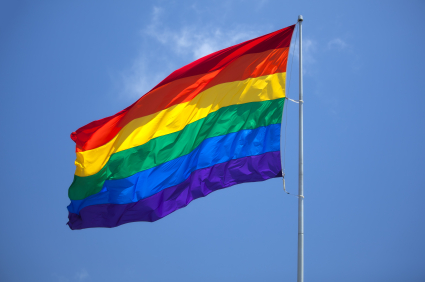
An increasing number of studies, although still limited, points to a higher prevalence of certain conditions among LGBT people that call for the attention of public health researchers and professionals. The most significant area of concern is the increased prevalence of mental health disorders. Recent studies show that LGBT youth are at greater risk for suicide attempts than non-LGBT youths and have higher prevalence of depression and anxiety diagnoses. Studies also show that transgender individuals are regularly stigmatized and discriminated against both in the health care sector and in the society as a whole.
Traditionally LGBT public health research has almost exclusively focused on sexually transmitted diseases. In particular, the start of the HIV/AIDS epidemic in the 1980s brought visibility to the LGBT population as a group with specific health needs. However, the public health consequences of discrimination of LGBT individuals have only recently been focus of greater attention.
The level of acceptance for minority sexual orientations differs greatly between countries. In the European Social Survey 2010, a question was used to assess level of acceptance of gay men and lesbians. The proportion of respondents that agreed to a statement that ‘Gay men and lesbians should be free to live their own life as they wish’ varied greatly between countries, from around 90% in the Netherlands, Sweden, and Norway to about one third of the respondents in Russia and Ukraine.

These results indicate that in many countries LGBT people still live in communities where a majority of the population supports discrimination and inequality for sexual minorities. In many countries, LGBT people are also subject to legal discrimination concerning basic civil rights, e.g. regarding recognition of same-sex unions.
But are these large differences in acceptance and legal discrimination influencing the health of LGBT individuals, and what needs to be done to overcome inequality in Europe’s health based on sexual orientation and gender identities? These questions are difficult to answer in the absence of sufficient data.
In a recent commentary in the European Journal of Public Health, we argue for greater awareness of these issues, and the need for more knowledge about the public health situation of LGBT populations through improved data quality and well-designed studies. Systematic data collection regarding sexual orientation and gender identity is required to better understand factors that can help us reduce and better understand disparities, as well as increase quality of health care provision for LGBT individuals. In addition to working towards greater acceptance to end discrimination and social injustice, greater efforts from public health researchers and policy makers are needed to reduce health disparities among LGBT populations.
Richard Bränström is a health psychologist and researcher. He is currently associate professor at the Karolinska Institute, Sweden, and he works with public health analyses at the Swedish National Institute of Public Health. His main research interest concern health inequalities, predictors of physical and mental health, and health related behaviors. He is the author of the commentary ‘All inclusive Public Health—what about LGBT populations?’, which is published in the European Journal of Public Health.
The European Journal of Public Health is a multidisciplinary journal in the field of public health, publishing contributions from social medicine, epidemiology, health services research, management, ethics and law, health economics, social sciences and environmental health.
Subscribe to the OUPblog via email or RSS.
Subscribe to only health and medicine articles on the OUPblog via email or RSS.
Image credit: Gay Pride. By chatursnil, via iStockphoto.
The post Are the differences in acceptance of LGBT individuals across Europe a public health concern? appeared first on OUPblog.

Title: Boyfriends with Girlfriends
Author: Alex Sanchez
Series: N/A
Published: April 2011 by Simon and Schuster
Length: 219 pagesSource: bought
Other info: Alex has written The Rainbow Boys trilogy (which I was going to review for Rainbow Reads but gave up after three pages so I'm not) and many other prominant LGBT books.
Summary : Lance has always known he was gay, but he's never had a real boyfriend. Sergio is bisexual, but his only real relationship was with a girl. When the two of them meet, they have an instant connection--but will it be enough to overcome their differences? Allie's been in a relationship with a guy for the last two years--but when she meets Kimiko, she can't get her out of her mind. Does this mean she's gay? Does it mean she's bi? Kimiko, falling hard for Allie, and finding it impossible to believe that a gorgeous girl like Allie would be into her, is willing to stick around and help Allie figure it out.
Boyfriends with Girlfriends is Alex Sanchez at his best, writing with a sensitive hand to portray four very real teens striving to find their places in the world--and with each other.
Review:Sergio is bisexual, Lance and Kimiko are gay, Allie's not entirely sure. A meet up with Sergio and Lance leads to them getting together, and to Kimiko and Allie maybe getting together. There's a lot of differences in between them, and lots of questions to be answered.
I added this to my wishlist because there's just not that many books with prominent bisexual characters (at least, I can't think of many), and I feel like I should know about what representation we do have.
Boyfriends with Girlfriends is a very character book. centering around two sets of romantic relationships and the relevant friendships involved. Both romantic relationships start at the start of the novel and develop very differently over the course of the novel.
I like the racial diversity (Sergio is Latino, I think, and Kimiko is Japanese). Sorry, in literature (most media really) there's not that many non-white queer characters, which is something I'd really like to see change over time.
The characters, I felt, were very stock-y. Three secure in their sexuality, one not, the lesbian being your standard cut out of cardboard uber dyke, many stereotypes for all of them, not much more than that to them. I kind of related to Sergio and Kimiko, Allie was nice enough, and Lance pissed me off to no end in the first half of the book.
The writing isn’t very good. It’s immature at times, and simple, and it didn’t make me want to keep reading.
Boyfriends with Girlfriends approaches bisexuality from opposite ends of the spectrum-the one confident and secure with his, and the one starting to discover hers.
I very much like the fact that Sergio constantly challenges Lance’s opinion that bisexuals are closeted homosexuals. Thank you someone for making that clear!
There’s some nice scenes with Kimiko’s family and Sergio’s family regarding acceptance, but these seemed to take a backseat which is sad, cos these were interesting.
I like the fact that not everything ends amazingly. With the way the relationships were going, it didn’t seem likely that they would, but still. This is kind of realistic.
Overall: Strength 2.5, slightly more a 3, to a book that looks at bisexuality well, but doesn’t do very well in terms of plot and character.
PS- datassguardian has very eloquently voiced the thoughts I have on this book. Posted with permission.

By: Jerry Beck,
on 6/29/2013
Blog:
Cartoon Brew
(
Login to Add to MyJacketFlap)
JacketFlap tags:
DOMA,
Monsters Inc,
Monsters University,
Darla K Anderson,
Defense of Marriage Act,
Kori Rae,
Cartoon Culture,
LGBT,
Pixar,
Pride,
Steve Jobs,
Add a tag
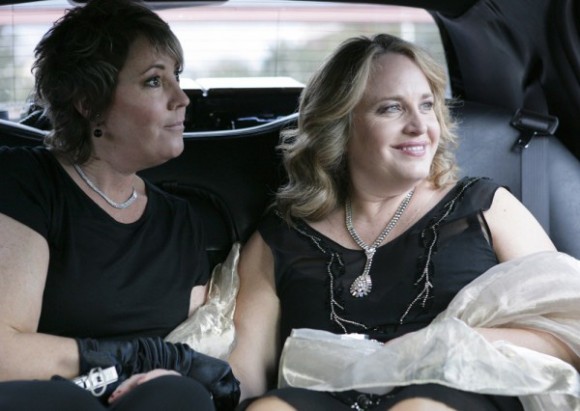 With LGBT Pride festivities taking place all over the country this week, the San Francisco Gate got together with Pixar power couple Kori Rae and Darla K. Anderson to chat about their relationship, the recent Supreme Court strike down of the Defense of Marriage Act (DOMA), and the box office opening of Monsters University, which Rae (above, left) produced.
With LGBT Pride festivities taking place all over the country this week, the San Francisco Gate got together with Pixar power couple Kori Rae and Darla K. Anderson to chat about their relationship, the recent Supreme Court strike down of the Defense of Marriage Act (DOMA), and the box office opening of Monsters University, which Rae (above, left) produced.
The twice-married (to each other), domestic-partnered producers and self-described “Pix-Mos”, Anderson (Monsters Inc., Cars, Toy Story 3) and Rae (Up, The Incredibles) started dating in 2001 during the production of Monsters Inc. and when they eloped in 2004, infuriated their family and friends, including Steve Jobs. “I remember Steve Jobs was mad,” Anderson recounted. “He said, ‘I can’t believe you didn’t invite Laurene and I to come down to City Hall to be with you guys.’”
“I was willing to leave the company at that point,” said Rae, expecting professional consequences to their new romance. “But [Pixar was] completely great. They were nothing but supportive, and have been the whole time.” The two maintain the sanity in their relationship by never working on the same film and maintaining strong boundaries. “It’s hard enough making one of these giant movies, and you put your heart and souls into them,” Anderson explained. “If we carried too much of that at home, we would just turn into animated characters ourselves.”
When asked if there will ever be (or has been) a gay character in a Pixar film, Anderson replied, “Our goal is to create great art, and if we’re telling true stories with great characters, people will project and identify with a lot of our films. A lot of people feel like a lot of our characters are gay, and have projected their stories onto it. If we’re doing our job right, that’s what should happen.”

By:
Jason Low,
on 3/13/2013
Blog:
The Open Book
(
Login to Add to MyJacketFlap)
JacketFlap tags:
Middle Eastern,
Asian/Asian American,
Latino/Hispanic/Mexican,
Awards,
Book News,
diversity,
first book,
LGBT,
Native American,
African/African American Interest,
Bellringers,
Race issues,
Multiracial,
Dear Readers,
Add a tag
In a groundbreaking announcement, First Book, a non-profit social enterprise launched the Stories for All Project. The project’s aim is to introduce a significant number of multicultural books into the hands of low-income children. LEE & LOW was chosen as one of two publishers to be a part of this endeavor and receive a $500,000 award.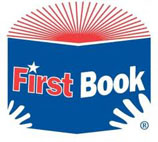
For us the presence of this project further addresses the fact that diverse books are a necessity. Making multicultural books available to low-income families is a step toward addressing the chasm between people who believe these books are important to actually making the books available to the children who need them.
For years I have been involved in conversations with librarians and educators on the subject of how we need more diverse books. However, there is this strange disconnect where people continue to point out the lack of diverse books without doing the most obvious thing, which is supporting the companies that publish these books in the first place. The support is simple. It involves buying the books. It also involves telling people about the books and recommending them to buy the books. The more this happens the more books we can publish.
What First Book has done is monumental in supporting multicultural books. It is a bold statement that I hope is just the beginning. An infusion of this many diverse books increases the chances of a child being able to see a face like his or her own staring back at them from the pages of a book. This moment of recognition for a child will create a profound experience that will be forever associated with the act of reading. This powerful relationship to books is one that they will hopefully cultivate for the rest of their lives.
On behalf of everyone at LEE & LOW I want to thank CEO Kyle Zimmer, Executive Vice President Chandler Arnold, Vice President Erica Perl, along with all the dedicated people working on the Stories for All Project. First Book’s commitment and dedication to literacy and multicultural literature is to be commended. This will be a game changer for many children who will be receiving their very first book ever.
Filed under:
Awards,
Bellringers,
Book News,
Dear Readers Tagged:
African/African American Interest,
Asian/Asian American,
diversity,
first book,
Latino/Hispanic/Mexican,
LGBT,
Middle Eastern,
Multiracial,
Native American,
Race issues 

.jpg?picon=980)
By:
Cheryl Rainfield,
on 10/2/2012
Blog:
Cheryl Rainfield: Avid Reader, Teen Fiction Writer, and Book-a-holic. Focus on Children & Teen Books
(
Login to Add to MyJacketFlap)
JacketFlap tags:
banned books,
gay,
lesbian,
queer,
incest,
sexual abuse,
LGBT,
banned books week,
banned YA books,
Cheryl Rainfield,
challenged books,
cutting,
Scars,
self-harm,
Add a tag
In the video below, I talk about Scars being challenged, why I wrote Scars, and the need for “dark” books – for Banned Book Week. I read banned and challenged books, and I hope you do, too!
Here are some of my favorite quotes about banning books and censorship:
“Books and ideas are the most effective weapons against intolerance and ignorance.”
- Lyndon Baines Johnson
“There are worse crimes than burning books. One of them is not reading them. ”
- Joseph Brodsky
“If all printers were determined not to print anything till they were sure it would offend nobody, there would be very little printed.”
- Benjamin Franklin
“Where they have burned books, they will end in burning human beings.”
- Heinrich Heine
“Think for yourselves and let others enjoy the privilege to do so, too.”
- Voltaire
Do you have a favorite quote about banned books or censorship? How about a favorite banned or challenged book? Let me know! 

By: Lisa Alvarado,
on 8/11/2012
Blog:
La Bloga
(
Login to Add to MyJacketFlap)
JacketFlap tags:
Puerto Rican,
Latina,
LGBT,
academia,
poets,
nationalism,
Latina authors,
Bilingual Poetry,
Latino Poetry,
Nuyorican,
Add a tag
Lisa Alvarado - Interview with Luz Maria Umpierre
Luz Maria Umpierre has wrought a legacy, a challenge, a history, a love letter, a sinuous and sentient record of personal identity, revealing the crosshatched scars and singing victories of a warrior, the yielding body and the body politic in
"I'm still standing- 30 Years of Poetry -available through her website
http://luzmaumpierre.com"Luz Maria Umpierre is, quite simply, one of my heroes in a postmodern world that insists on ridding us of icons and pedestals in an attempt to level all people and institutions. Paradoxically, some institutions seem to merit such debasement when they never miss an opportunity to hound the historically marginalized and alternative voices out of the academy." Dr.Eric Pennington (Seton Hall)
She is an established scholar in the fields of Puerto Rican, Caribbean, Latina/o Studies, Poetry, and Gender Studies, with multiple publications in leading journals, including Hispania, Latin American Theatre Review, Revista do Estudios Hispánicos, Bilingual Review, Chasqui, Explicación do Textos Literarios, Chicana/Latina Studies and The Americas Review. Co-founder of the journal, Third Woman. Also published in internet journals, including La Acera, Diálogo Digital, Cruce and La Bloga.
Author of two books of literary criticism, ten collections of bilingual poetry, numerous book chapters and over 50 articles of literary criticism on Latin American scholars and writers from several generations, including a seminal article on writers and migration published in MELUS in 2002 and currently included in an anthology of essays in honor of Isabel Allende.
Her collected works and personal papers currently housed at De Paul University, Latina rare book collection housed at Bryn Mawr College.
She is recognized internationally as an authority on the interdisciplinary study of Literature, the Social Sciences, History and Language, especially regarding race, culture, gender identity and ethnicity. Complete list of publications available on request.
What do you believe is the purpose of poetry?The purpose of poetry is to liberate the spirit, our soul, so that it has a concrete expression that is palpable. And as Julia Alvarez said in one of my favorite poems of all times, to be able to say "Whoever reads this poem, touches a woman." I am hoping that I am quoting her correctly because my copy of her book is at my rare book collection at Bryn Mawr. I can and will accept to be corrected in my quote but not in my idea. LOL
What do you consider to be "Latino/a" themes?All themes are Latina themes. It is the vision or the approach we take as Latinas what gives them a sabor or authenticity that is ours. For example, many years ago I took Vanguardista poetry which was highly non-politicized and turned it into political poetry. From there, for example, emerged my Poemas Concretistas.
To say that there are Latina themes is to reduce us. Granted there are subject matters such as identity that we explore more than other groups of writers but I would not say that there are Latina themes and non Latina themes. All themes are human themes and that is overall the most important theme to me.
Describe the intersection of sexual identity and culture as it lives in your writing?I learned from Audre Lorde years and years ago that I cannot be asked to divide my Self into separate pieces of identity and ignore some in favor of others. That to me would be mutilation. I refuse to mutilate my rich identity for the sake of pleasing the eye of a beholder or for an aesthetics of a political correctdness of beauty. Thus all aspects of my identity and culture live in harmony in my works.
What would you say to critics of your lesbian-identified work? That they get a life and start living in the 21st. century. I never forced them to leave their heterosexist and nationalist macho agenda views through meanness, non inclusion or actual shuning. On the contrary, I questioned them publicly and made my dissenting opinions known to them. I did not go back stabbing them, making calls to bad mouth them into being denied jobs, I did not refuse to teach them in my classes. To the contrary, I included them because I wanted to have an open dialogue about difference. But "I'm Still Standing" as the only dancer on that inclusion floor because some of these people are so petty that they refuse to engage me in public and face to face or, as Lorraine Sutton marvelously said in one of her poems: "to cunt-front" me.
How has academia enhanced/impinged upon your creative process?They have always wanted to deny me a claim to my poetry as an academic achievement. However, I have not allowed them to infringe on my freedom to write. I have used my academic struggles precisely to question antics and tactics in academia and make fun, mock and criticize their elitism and snobbery.
Who are some authors who move you and why? Adrienne Rich, her book The Dream of A Common Language has been my Bible since the 1980s. Nemir Matos Cintron has poems in her collections A través del aire y del fuego pero no del cristal and in Aliens in NYC that have made me cry time and time again because of her portrayal of genuine human identity angst. I recently re/read a poem by Ana Castillo entitled: "I Ask The Impossible" and I am afraid that I ruined the Thai Lemon Tilapia dish that I was eating while reading it because I began to cry uncontrollably. I feel that we have all have wanted to be loved that way and her poem is a voicing of a human need that I had never read exposed in poetry. Lorde also moved me with some of her poems on women. Marge Piercy's book The Moon is Always Female has some of my favorite poems of all times because of her delving into what constitutes to be a strong woman. Julia de Burgos, of course she is part of our collective unconscious as Puerto Ricans. The theme of the river in her poetry and the sea attracts me.
What are some thoughts you would share with newer poetas/poetisas/Nuyorican poets?To remember that many people paved a path for them and they should be honored, not bullied, harassed, shunned and most importantly, not disrespected.
I think Puerto Rican poets of the younger generation have no respect towards their elders, their sages, those who broke a path for them now to enjoy. They are not like other Latina groups. I am marveled by the respect of Mexican Americans towards their wiser older Latinas/Latinos something that is totally lacking among young poets be they Puerto Rican or Nuyorican.
I would like to let them know that one day they will inevitably be older and if they do not change their ways and attitudes, they too will be the subject of disrespect.
What sustains your creative and spiritual longevity?The power to love, to find love, to see everything with fresh eyes, to be able to marvel at beauty and to be passionate about living. But also, as the poem says: "To be of use."
By: Stacy Dillon,
on 7/21/2012
Blog:
Welcome to my Tweendom
(
Login to Add to MyJacketFlap)
JacketFlap tags:
summer,
families,
Vermont,
lgbt,
pie contests,
arc from publisher,
Houghton Mifflin Books for Children,
arc 5/12,
Friendship,
Add a tag
June has been content living with her mother on the shores of Lake Champlain, spending her time baking and selling sweets at the Stillwater Marina, and swimming with her friend Luke. This summer she is dreaming of what pie she is going to enter in the Champlain Valley Fair. It seems pretty ideal, yes?
It is pretty ideal except for Eva. Eva has just moved in with June and her mom. It's not like June didn't know that her mom was gay, but having Eva living with them is making June uncomfortable. After all, June and MJ have always had a rhythm, and Eva just doesn't fit. Now that Vermont's civil union law has passed, Eva and MJ are even talking about getting married!
But not everyone in their town is happy with the idea of civil unions. In fact, someone even had the nerve to put a "Take Back Vermont" sign on their front lawn. June isn't even sure what that means, but she doesn't stick around to find out. After Eva tears up the sign, June takes off with Luke to see the secret blueberry bushes that he found up by the jumping cliff. June can't wait to come back the next week to pick some for her pies. Before she and Luke leave, however, June's friend Tina's brother Sam and some of his friends show up. Sam calls June a "lezzie" for being too scared to jump off the cliff, and June starts to wonder if Sam put up the sign on her lawn. And does Tina feel the same way her brother does?
Soon the "Take Back Vermont" campaign starts to take off in town. Folks stop coming into the marina, and June starts to worry about her mom. But there are others who are willing to stick up for June, Eva and MJ, and June starts to realize that she needs to stick up for her family as well.
Overall this is a coming of age story that easily could have turned into a didactic piece about marriage equity. Gennari has managed to balance the discussion with June's struggles with friendships, her blossoming crush on Luke as well as the everyday growing pains that families go through. I am always on the look out for LGBT books to put in our collection, and honestly ones that fit the tween audience are hard to come by.
My Mixed-Up Berry Blue Summer fits nicely into not only the LGBT collection, but into tween summer reads as well.
June is LGBT Pride Month, and throughout this month people everywhere (including President Obama) have been celebrating the positive impact that lesbian, gay, bisexual, and transgender people have had in the world. The fight for LGBT rights has always been a matter of civil rights and equality, as our publisher noted in a recent post, and it’s nice that we live in an era when that’s acknowledged by so many people.
As for us, we’re excited to continue expanding our definition of diversity to include LGBT diversity. Here are three titles with gay or lesbian main characters:
 Antonio’s Card/ La tarjeta de Antonio, by Rigoberto González, illustrated by Cecilia Concepción Álvarez
Antonio’s Card/ La tarjeta de Antonio, by Rigoberto González, illustrated by Cecilia Concepción Álvarez
Antonio’s Card was originally published by Children’s Book Press in 2006 and is now part of our new CBP imprint. It tells the story of Antonio as he struggles to find the words to express his love for his mother and her partner, Leslie, as Mother’s Day approaches.
Cat Girl’s Day Off, by Kimberly Pauley
In this YA novel, Nat’s Talent of talking to cats pulls her into a madcap adventure through Chicago with best friends Melly and Oscar (who is gay).
Diverse Energies, edited by Joe Monti and Tobias S. Buckell
Coming this fall, Diverse Energies is a dystopian anthology with a focus on diversity – all types of diversity, including racial diversity, LGBT diversity, and of course, some very diverse visions of both the future and the past. Contributing authors include Ursula K. LeGuin, Paolo Bacigalupi, Malinda Lo, Cindy Pon, and more. Stay tuned on the blog for more information.
We hope to add more titles to this list soon. Adding more books with LGBT diversity is a natural extension of our mission to meet the need for stories that all children can identify with and enjoy.
What are your favorite LGBT books? Share ‘em in the comments!
Filed under:
Holidays,
Musings & Ponderings Tagged:
Children's Book Press,
diversity,
LGBT,
Teens/YA,
Tu Books 
 0 Comments on Happy LGBT Pride Month! as of 1/1/1900
0 Comments on Happy LGBT Pride Month! as of 1/1/1900












 ‘
‘
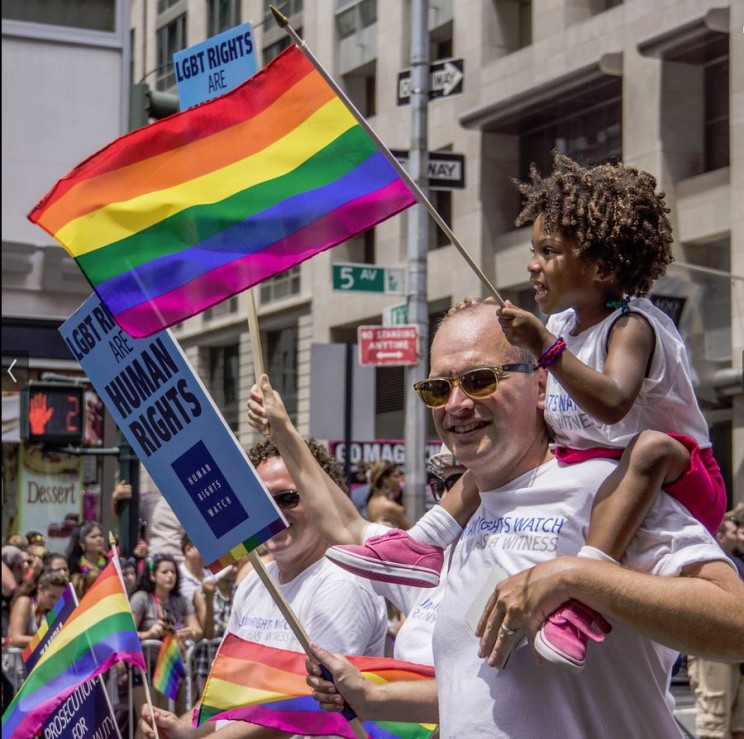
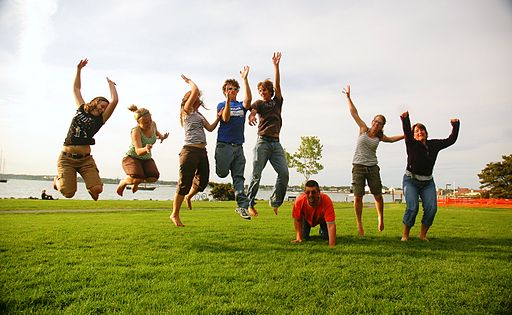


















 With LGBT Pride festivities taking place all over the country this week, the
With LGBT Pride festivities taking place all over the country this week, the 





 Independence ”that all men are created equal,” and over time equal rights have been gradually extended to different groups of people. However, equality has never been achieved without heated debate, despite our country’s founding principle that all people are created equal in the first place.
Independence ”that all men are created equal,” and over time equal rights have been gradually extended to different groups of people. However, equality has never been achieved without heated debate, despite our country’s founding principle that all people are created equal in the first place.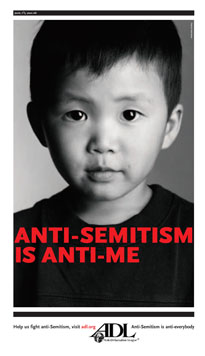 vehemently demanded the right to vote, think it was fine for African Americans to be denied this same right? It depends. My theory also includes the caveat that empathy for others does not always translate into citizens banding together for the greater good. Then again, the social evolution of the United States is progressing. This progression is the reason the language and message of equality remains relevant.
vehemently demanded the right to vote, think it was fine for African Americans to be denied this same right? It depends. My theory also includes the caveat that empathy for others does not always translate into citizens banding together for the greater good. Then again, the social evolution of the United States is progressing. This progression is the reason the language and message of equality remains relevant.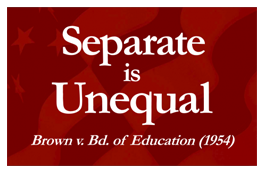 Jefferson’s words made a statement about human rights that became the foundation for a country unlike any other in the world. The signers never anticipated that their vision would eventually embrace so many different kinds of people, but that is the beauty of it. The Declaration was groundbreaking because it provided a foundation of principles and moral standards that have endured to modern times and that accommodate human evolution and its capacity for acceptance.
Jefferson’s words made a statement about human rights that became the foundation for a country unlike any other in the world. The signers never anticipated that their vision would eventually embrace so many different kinds of people, but that is the beauty of it. The Declaration was groundbreaking because it provided a foundation of principles and moral standards that have endured to modern times and that accommodate human evolution and its capacity for acceptance.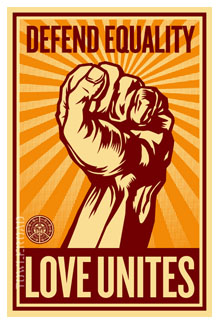 repeat the same mistakes over and over. However, I believe that the preservation and repurposing of the messages of protest in all their different forms are evidence that we do learn from history, and that we apply these tactics when the moment calls for them.
repeat the same mistakes over and over. However, I believe that the preservation and repurposing of the messages of protest in all their different forms are evidence that we do learn from history, and that we apply these tactics when the moment calls for them.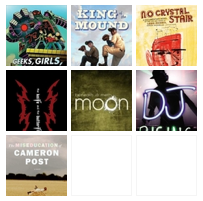




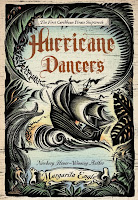





Wow, this is depressing. 6 of 8 are Will Smith… It’s really hard to surprise me with bad diversity news out of Hollywood, but that did.
Great job as usual, Lee and Low team!